
views
- Do resistance exercises like squats, lunges, calf raises, leg curls, step ups, and deadlifts 2 to 3 times a week to strengthen your leg muscles.
- Cross-train with cardio exercises that work your legs, such as cycling, swimming, and playing sports.
- When you work out, always warm-up with 5 to 10 minutes of cardio and cool-down with stretches to reduce your risk of injury.
Resistance Training

Squats Start with your feet about shoulder-width apart and your arms at your sides. Then, slowly lower yourself back like you’re sitting in a chair, keeping your back straight. Pause for a second, then slowly rise back to a standing position. Do 10 squats to make a set, and complete 2 sets per workout. Sumo squats: To do a sumo squat, spread your legs out more than shoulder-width apart and point your toes outward. Then, lower your body into a sitting position before rising slowly back to standing. Goblet squat: Like with a sumo squat, spread your legs wide and point your toes out. Hold a kettlebell or dumbbell with both hands, with the weight hanging in front of your chest. Then, do your squats. Jump squats: With a jump squat, start with your legs a little wider than hip-width apart. Sit back like you’re doing a regular squat, then propel yourself up into a jump. Go directly into your next squat and continue until you finish your set.
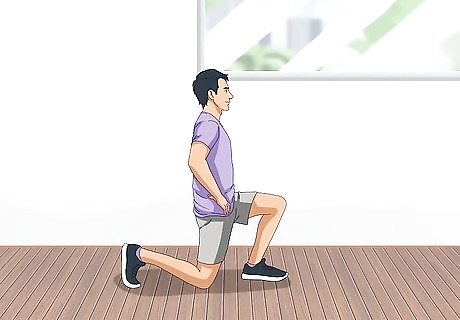
Lunges Stand up straight with your feet about shoulder-width apart and your arms at your sides. Then, step forward with one leg and bend your knees until your legs are bent at 90-degree angles. Make sure to keep your back straight as you lunge forward. Pause for 1 second, then slowly rise back up to a standing position. Do 2 to 3 sets of 10-15 lunges on each side. Reverse lunge: Start in a standing position with your feet about hip-width apart. Then, step back and bend your knees to lower yourself down toward the ground. Pause when your front knee is bent at a 90-degree angle, then slowly come back up. Side lunge: To do a side lunge, step out to the side rather than to the front or back. Dumbbell lunge: For a dumbbell lunge, hold a weight in each hand, at your hips or down at your sides, while you do your lunges.
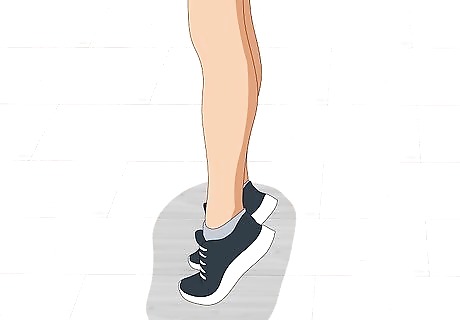
Calf raises Stand up straight with your legs about hip-width apart. Keep your knees straight, but don’t lock them. Then, slowly rise up onto the balls of your feet as high as you can go. Pause for 1 second, and then lower yourself back down. Do 8 to 12 calf raises per set, and complete 2 to 3 sets. Pause about 30 seconds between your sets to give your muscles a moment to recover. If you need help balancing, grab onto a chair or other sturdy piece of furniture for extra support.
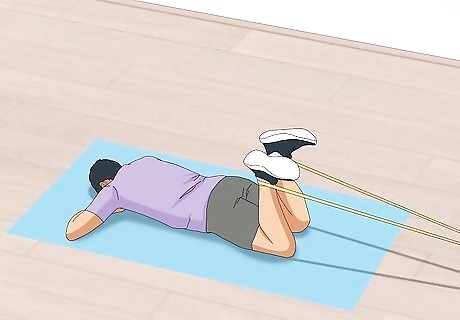
Leg curls Wrap a resistance band around something sturdy that’s just above the floor, like your sofa leg. Then, lie on your stomach and wrap the end of the band around both of your ankles. Crawl forward until you have some tension in your resistance bands. Then, lie on your stomach and bend your knees to curl your legs toward your bum as far as you can. Pause for a second, then slowly lower your legs back to start. Do 2 to 3 sets of 10 to 15 reps.
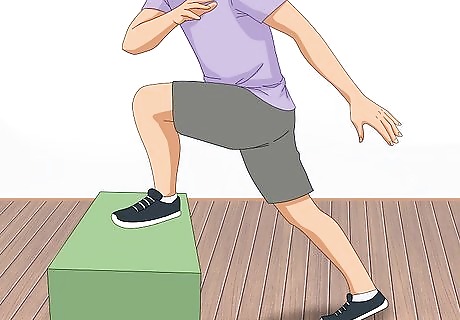
Step ups Stand in front of a step or a sturdy box. Then, place your right leg on the step or box. With your left leg, slowly step up and touch the step with your toe. Pause, then lower your left leg back to the floor. Make sure your right leg is doing all of the work. Repeat 10 step ups, then switch sides. Do 2 sets on each side, resting about 1 minute between your sets.
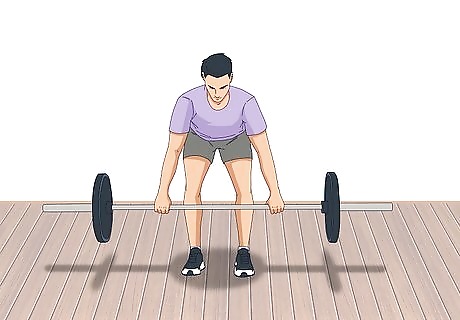
Deadlifts Place a weighted barbell in front of you. Bend your knees and squat down, then grasp your weight. Slowly stand up, keeping your back straight and the weight close to your body. Stop when the weight reaches your thigh and pause for a second before lowering the weight back to the floor. Do 2 sets of 10 to 15 deadlifts. Romanian deadlifts: In a Romanian deadlift, you don’t put your weight down between reps. Instead, stop when the weight is hovering over the floor and go into your next set. This works especially well if you have dumbbells or a kettlebell instead of a barbell.
Cross-Training
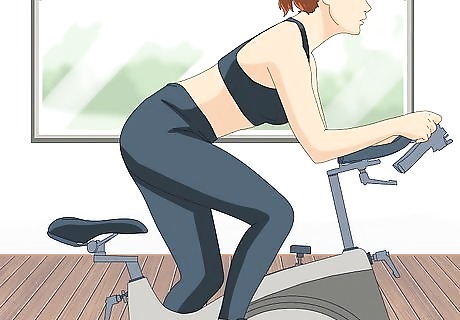
Go cycling. Riding a bicycle or using a stationary bike is a great way to work your leg muscles. You’ll strengthen your leg muscles and reach your cardio goals at the same time. Ride a bike around your neighborhood or along a local bike path for a fun way to exercise. As an alternative, use a stationary bike at home or your local gym. Cycle for at least 10 minutes to make your workout count.
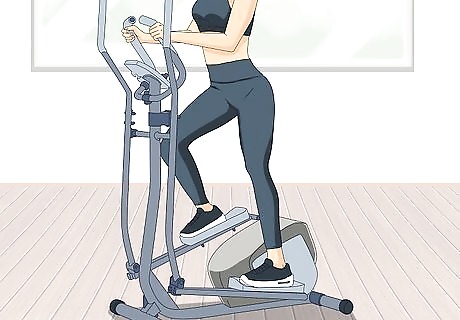
Use an elliptical. If you prefer to work out on a machine, the elliptical is a great option for a good leg workout. Choose a challenging incline so that your leg muscles have to work harder. While using the elliptical, your toes may start tingling because they’re being forced against the front of your shoe. If this happens, simply switch directions and pedal in reverse. When you’re first using an elliptical, only do 10 minutes so you don’t over do it. Increase your workout length when you stop feeling challenged.
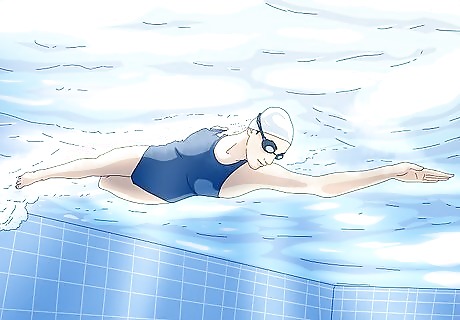
Swim laps. Swimming is a great whole-body workout because water provides resistance, which makes your muscles work harder. It’s also low-impact, so it’s easy on your body. For a fun workout, dive into the water and swim laps around the pool. If you don’t have access to a pool at home, look for a community pool in your area, a local natatorium, or a gym that has a pool. Some schools will also let the community use their pool on certain days.

Play recreational sports. Most sports help strengthen your legs if you’re giving it all you’ve got. For instance, soccer, rugby, and hockey all give you a leg workout. Basketball and football are also great options. Join a local sports team or invite your friends to play a game in the park. Sports are a great way to have fun while getting your exercise.
Planning Workouts
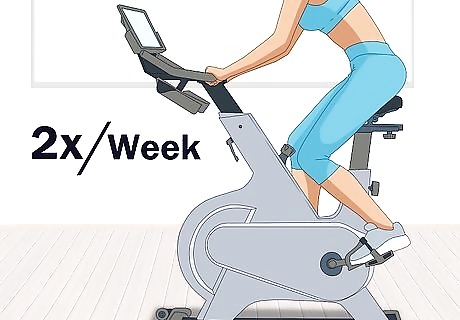
Do strength training 2 to 3 times a week. When it comes to resistance exercises, you'll get great results with just a couple of workouts each week. In fact, your body needs to recover for at least a day in between strength training sessions. On your other workout days, do your cross-training workouts, such as cycling. Some experts say you should rest at least 48 hours between strength training workouts. If your muscles are still sore, it might be best for you to wait another day to do strength training.

Do cross training exercises that count as cardio. For good health, you need 150 minutes of moderate exercise or 75 minutes of vigorous exercise each week. You don’t have to do all of your exercise in big blocks, though, because 10-minute sessions can be just as effective as long bouts of exercise. Break up your workouts in a way that’s convenient for you. You could try: 30 minutes of moderate exercise 5 days a week. 50 minutes of moderate exercise 3 days a week. 25 minutes of vigorous exercise 3 days a week. 10 to 15 minutes of vigorous exercise 5 days a week.

Give yourself 1 or 2 rest days. Taking a rest day can actually help your progress because it gives your body time to recover and repair your muscles. Additionally, resting helps you prevent injuries, which will help you stick to your workout goals. Schedule yourself some rest days when you’re planning out your workouts. It’s okay to do yoga or take a leisurely walk on your rest day.
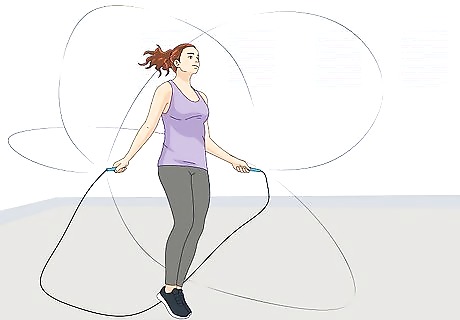
Warm up for 5 to 10 minutes before you workout. When you’re warmed up, you’re less likely to hurt yourself during a workout. To get your body ready for exercise, walk or do aerobic activity for at least 5 minutes. Make it fun by: Dancing. Jumping rope. Taking a walk outside.

Stretch your muscles to cool down after your workout. A good stretch helps prevent injuries and soreness after a workout. Take about 5 to 10 minutes to stretch out all of your muscle groups after you do strength training or cross training. It’s better to stretch after your workout when your muscles are warm, rather than before your workout. Stretch in smooth motions. Do not bounce when stretching as this can cause injury. Make sure you breathe during stretching and hold each stretch for 30-60 seconds minimum.
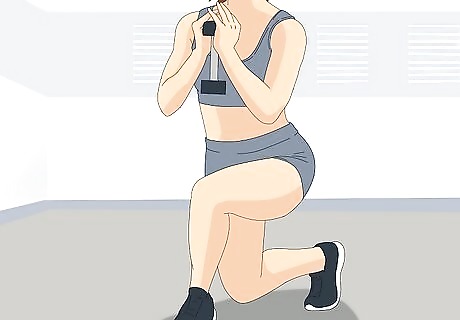
Be consistent until you see results. While it takes time to get stronger, you’ll probably notice small changes along the way. Keep going because repetition is what’s going to help you get stronger legs. Just stick with your workouts and you’ll make progress toward your goals. Once the exercises become easy, try adding weights or increasing how much weight you’re using. You could also add a set or increase the number of reps you do.
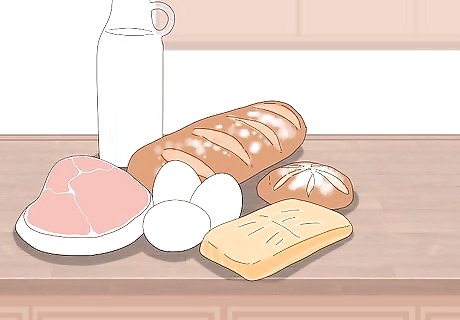
Eat healthy to help build muscle. Beyond committing to a consistent workout, eating well will ensure you are getting a good dose of vitamins, minerals, and nutrients every day. A balanced diet also means you'll have more energy to complete your workout plan, giving you the right fuel to tone and strengthen your body. Balance is key. Try to eat from each food group — grains, protein foods, vegetables and fruits, and dairy. Eat moderately. Don't have too much or too little of one thing. All foods, if eaten in moderation, can be part of healthy eating. Even a cookie or some ice cream can be okay, as long as it's balanced out with other, healthier foods.




















Comments
0 comment